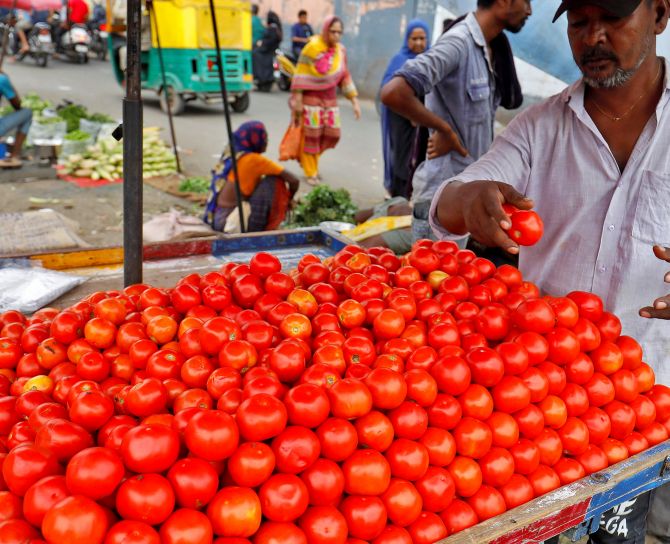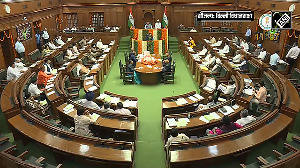Tomato prices have been on the boil for more than a month. Data from major cities show that the spike has been between 125 and 150 per cent at the wholesale level.

Soaring vegetable prices, including tomatoes, pushed the retail inflation rate to a nine-month high of 5.49 per cent in September, according to government data.
Though reports say prices are expected to come down in the next few weeks after supplies improve from Madhya Pradesh and Himachal Pradesh, how long will the respite last is anybody’s guess.
The central government has been selling tomatoes at subsidised rates for the last few days in the national capital of Delhi to tame prices.
In fact, among the three vegetables that constitute the trio of TOP (tomato, onion, and potato), tomato is believed to experience the most volatility in prices. For that, the reasons are many.
Wasted and lost
A study by the World Resources Institute India (WRI) in three districts of Madhya Pradesh, which is one of the major growing states for the commodity, shows that around 15 per cent of tomatoes are lost or wasted at the farm level, and 12 per cent at the retail level.
The findings were released recently.
WRI India works with local and national governments, businesses, and civil society to address India’s development challenges.
The main reasons for the losses at the farm gate levels, according to respondents to the study, were poor production, harvesting, and postharvest practices, such as harvesting time and method, packaging, and temporary storage.
The respondents also cited lack of adequate infrastructure for storage, handling, and processing, and unforeseen weather conditions.
At the retail level, the main causes identified for the loss and wastage include pests and disease infestation during production, unforeseen weather conditions, and poor management practices in packaging and temporary storage, lack of storage alternatives, and consumer preferences that drive cosmetic specifications.
India annually produces 20 to 21 million tonnes of tomato.
The scope of the study was limited to wholesale markets and retailers, mostly unorganised, in the selected geography.
According to a 2022 study by Nabard Consultancy Private Ltd (NABCONS) of fruits and vegetables, tomato incurs the second highest postharvest losses (11.61 per cent), after guava (15 per cent).
Production cycle
A recent working paper by the Reserve Bank of India (RBI), written by noted agriculture economist Ashok Gulati and others, shows the major tomato producing states including Andhra Pradesh, Madhya Pradesh, Karnataka, Gujarat, Tamil Nadu, and West Bengal together account for 57 per cent of the total production.
The transplanting and harvesting months also vary across states, with major production (67 per cent) coming from Rabi months.
In states such as Andhra Pradesh, Gujarat, and Maharashtra, tomatoes are produced almost every year.
In other producing states such as Karnataka and Madhya Pradesh, the peak season is during the months of August to October and October to December, respectively.
In West Bengal and Uttar Pradesh, most of the harvesting takes place during November-January.
The paper says that between 2014-15 and 2022-23, tomato yield increased from 21.3 tonnes per hectare to 24.0 tonnes per hectare.
The RBI paper notes that tomato cultivation mainly involves marginal and small farmers who account for 82.1 per cent of total land holdings.
This also means that their capacity to store and sell at a future date is limited during peak production cycles, which ensures that farmers dump their output during the production months while consumers end up paying through their nose during a supply squeeze.
With a crop duration of 3 to 4.5 months, tomato is sowed on raised beds.
There has been an improvement in yield in the last decade due to the introduction of hybrid seeds as well as marketing and processing.
Tomato cultivation in India is predominantly open-field cultivation rather than poly-house cultivation, which can help multiply the yield levels by way of vertical farming, the paper says.
Farmers usually bring their tomatoes to the mandi (Agricultural Produce and Livestock Market Committee, or APMC).
The first level of sorting and grading in three grades is performed by the farmer at the farm gate itself.
The farmer has the option of selling to organised retailing, such as HOPCOMS (Horticultural Producers’ Co-operative Marketing and Processing Society Ltd), SAFAL Market, and Namdhari Fresh.
Processing units either procure tomatoes from mandis or directly from farmers.
Price volatility
The RBI paper further says that since tomato is a short-duration crop, supply-side shock gets translated into prices fast, causing volatility in retail prices.
The latest spike, too, is largely due to surplus monsoon rains in the major growing states of Andhra Pradesh, Karnataka, and Maharashtra that have led to deterioration in the quality of the standing crop.
The three states account for almost 27 per cent of the country’s annual tomato production.
Data from the India Meteorological Department says that the southwest monsoon was surplus by 20 per cent in central India and 14 per cent in the Southern Peninsula.
Major tomato-growing states fall in these two regions of the country.
Will farmers benefit?
Not much, because, as the RBI paper says, tomato is among the crops for which farmers get the least share of every rupee a consumer spends.
The paper estimates farmers’ share in the consumer rupee to be around 33.5 per cent for tomato, 36 per cent for onion, and 37 per cent for potato.
In contrast, eggs and chana farmers get nearly 75 per cent of every rupee spent by consumers.
“As per the calculations, traders (selling tomatoes) earn an average of 5.3 per cent margin.
"The same is true for wholesalers in the secondary market,” the RBI paper notes.
It says the highest margin in the tomato value chain is apportioned by the retailer, who bears the highest risk of perishability and wastage.
“This is because tomatoes are mostly sold in unorganised markets, and they have to incur transportation costs and shop rentals,” the paper states.
The solution
A quick nationwide spread of tomato hybrids that have longer shelf life could provide some remedy for volatile prices.
Conventional tomato varieties in non-refrigerated conditions usually have a shelf life of seven to 10 days, but there are new hybrids available that boast an impressive shelf life of up to three weeks.
These varieties are also resistant to no less than three diseases that infect tomatoes, including the dreaded late blight.
Ashok Gulati, in a newspaper article some time back, said that to bring down inflation in tomato the Centre should ensure that at least 10 per cent of the annual production is processed into purees which can be stored and used any time and the GST on processed tomato needs to be lowered.
The gap between farm to plate also needs to be curtailed.
Solutions are aplenty. One only needs to work on them.












 © 2025
© 2025